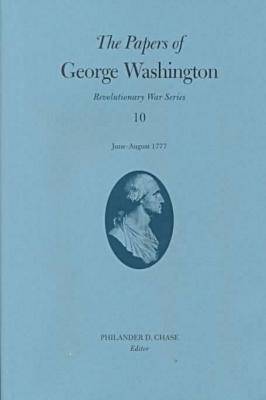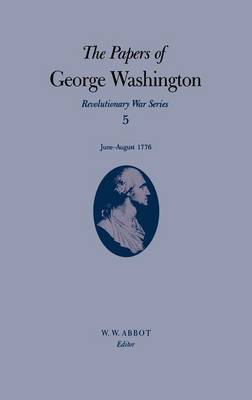The Papers of George Washington: Revolutionary War
3 total works
The Papers of George Washington v.10; Revolutionary War Series;June -August 1777
by George Washington
Volume 10 of the Revolutionary War Series opens with Washington headquartered at the Continental army's encampment at Middlebrook, New Jersey, about seven miles northeast of New Brunswick, the location of the main British force under General William Howe. From this strategic vantage point in the Watchung Mountains, Washington could survey the country between Perth Amboy and New Brunswick while keeping an eye on the road to Philadelphia. Here he weighed contradictory intelligence reports. "The views of the Enemy," surmised Washington, "must be to give a severe blow to this Army and to get possession of Philada. Both are objects of importance; but the former of far the greatest--while we have a respectable force in the field, every acquisition of territory they may make will be precarious and perhaps burthensome." Washington also considered the possibility that Howe might attempt torendezvous his army with General Burgoyne's, thought to be en route fromQuebec to Albany by way of Lake Champlain and the Hudson River.
For his part, Howe, whose army outnumbered the Americans by a margin of more than two to one, hoped to lure Washington away from his defensive positions and force a general engagement. When a series of British maneuvers in late June failed to bring on the desired fight, Howe evacuated his army from New Jersey to Staten Island, leaving Washington completely in the dark as to the enemy's next move and keenly aware of "the great advantage they derive from their navy." Although Howe had abandoned the idea of attacking the main Continental army, from his new disposition the British commander easily could join with Burgoyne via the Hudson, move upon Philadelphia by way of the Delaware River or the Chesapeake Bay, sail farther south into Virginia or to Charleston, South Carolina, or sail northward and invade one of the New England states.
Washington's repositioned his army back at its old camp at Morristown, where it could better assist the American troops at Peekskill, New York, if Howe moved up the Hudson and yet still interfere with any British designs upon Philadelphia. Although surveillance reports revealed that the British were preparing for "a longer Voyage than up the North River," the British capture of Ticonderoga, New York, convinced Washington that Howe would take the northern route, and he swiftly marched the Continental army into New York state, where it remained until it became clear that the British fleet had gone out to sea. Washington then returned to New Jersey, where he made preparations for the defense of Philadelphia, but with several critical weeks of the summer campaign already passed, he confessed his puzzlement at his foe's decision to sail south.
The Papers of George Washington v.5; Revolutionary War Series;June-August 1776
by George Washington
Volume 5 covers the preliminary phase of the New York campaign, the period from mid-June to mid-August 1776 when the stage was set for Washington's greatest challenge yet as commander in chief of the Continental army. As the summer weeks passed, the British concentrated a massive military force in New York Harbor, bringing in thousands of Redcoats and German mercenaries backed by the guns of a large fleet. "The Powers of Despotism," Washington wrote in August, "are all combined against [America], and ready to strike their most decisive Stroke." Not knowing exactly where the stroke would fall, Washington wrote urgently to Congress and the states seeking reinforcements for the extensive lines that he was obliged to defend, while vigorously pushing forward construction of fortifcations and efforts to obstruct the Hudson River. At every opportunity he sought and read any piece of intelligence regarding the enemy force and its intentions.
Washington could not focus his thoughts solely on the defense of New York City, however, for letters from the north informed him of the disastrous American retreat from Canada. That alarming situation elicited from Washington detailed consideration of the strategy to be pursued in defensing the upper end of the vital Hudson River-Lake Champlain corridor. Other correspondence concerned threats from internal enemies, conspiracies allegedly fomented by disaffected persons to undermine the American cause through subversion and sabotage. Such reports resulted in the execution of Thomas Hickey, a soldier in Washington's personal guard, for treachery in late June and the forced removal of many suspicious persons from New York City a short time later. Although the reading of the Declaration of Independence to the Continental army in early July boosted its morale, Washington continued his unrelenting efforts to check disorder and discord at all levels and to overcome the spirit of disunity that threatened the American cause as much as did British arms. "Let all distinctions of Nations, Countries, and Provinces," he told his men on 1 August, "be lost in the generous contest, who shall behave with the most Courage against the enemy, and the most kindness and good humor to each other." Washington's roles as miltary commander and political leader cannot be separated.
The Papers of George Washington v.6; 13 August-20 October, 1776;13 August-20 October, 1776
by George Washington
Volume 6 documents Washington's decisions and actions during the heart of the New York campaign--the period from late summer to early fall 1776 when his British opponent, General William Howe, took the offensive and outmaneuvered the American forces in and around New York City through a series of amphibious landings. Faced with an enemy superior in numbers, mobility, and discipline, Washington attempted to defend New York by placing his green troops behind fortifications on high ground and hoping that courage and patriotism would offset their lack of experience and training. That strategy failed at the Battle of Long Island on 27 August when Howe's army outflanked and routed a larger American force on the Heights of Guana. Two nights later Washington reunited his dangerously divided army by skillfully evacuating every man and most stores and equipment from Long Island to New York City.
During the following weeks Washington spared no one including himself in an effort to restore order and confidence to his badly dispirited troops. He also reassessed his strategy and concluded "that on our side the War should be defensive" and "that we should on all occasions avoid a general Action or put anything to the risque unless compelled by a necessity into which we ought never to be drawn." Reluctantly deciding to abandon New York City, Washington narrowly avoided being forced into a disadvantageous general engagement on 15 September when he marched his army north to defensive positions on Harlem Heights ahead of British and Hessian soldiers landing at Kip's Bay. Although the Battle of Harlem Heights on the following day was an indecisive skirmish between detachments, it raised American morale by showing that some of their troops could and would fight well against enemy regulars in limited actions.
Military concerns so preoccupied Washington that at times his secretary Robert Hanson Harrison had to write the president of Congress and other public officials for him. This volume, nevertheless, includes four long letters that Washington wrote to his plantation manager Lund Washington describing his situation in New York and giving detailed instructions regarding such matters as the sale of flour from the Mount Vernon mill, the remodeling of the mansion house, and the planting of trees around it.


